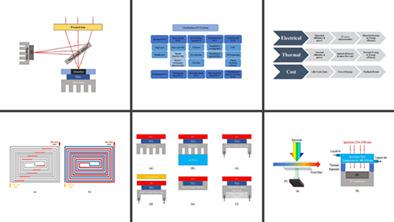当前位置:
X-MOL 学术
›
Int. J. Energy Res.
›
论文详情
Our official English website, www.x-mol.net, welcomes your
feedback! (Note: you will need to create a separate account there.)
A review of photovoltaic thermal systems: Achievements and applications
International Journal of Energy Research ( IF 4.3 ) Pub Date : 2020-09-14 , DOI: 10.1002/er.5872 Ali H. A. Al‐Waeli 1 , Hussein A. Kazem 1, 2 , Miqdam T. Chaichan 3 , K. Sopian 1
International Journal of Energy Research ( IF 4.3 ) Pub Date : 2020-09-14 , DOI: 10.1002/er.5872 Ali H. A. Al‐Waeli 1 , Hussein A. Kazem 1, 2 , Miqdam T. Chaichan 3 , K. Sopian 1
Affiliation

|
The use of photovoltaics has spread widely, and government agencies have begun adopting plans to deploy plants with large capacities, due to their environmental friendliness, low manufacturing costs, and high productivity. In the sunny countries where this technology should spread, the photovoltaics' energy conversion efficiency decreases due to the high temperature of which the cell's operate at; because a large part of the solar radiation is absorbed by the solar panels as heat, while the smaller part converts it to electricity. From here, the benefit of the shift towards the PV/T technology that works to reduce the photovoltaic modules temperature and improve their electricity produced along with yielded thermal energy which can be utilized in other applications. In this study, a thorough review of many recent research and studies published in the field of PV/T has been carried out. The present study was divided into several sections to clarify and focus on the effect of each technology separately. Researchers used one or more fluids to cool the solar panels, and their research dealt with many of these fluids, starting with air, water, oil, etc. Other researchers have tended to increase the thermal conductivity of liquid cooling fluids by adding many types of nanoparticles with high thermal conductivity. Other researchers have used variable‐phase materials to take advantage of the large storage of the latent heat of these materials. Other researchers have studied improving heat transfer of PCMs by mixing it with nanomaterials with high thermal conductivity. Others have also combined nano‐PCMs and nanofluids together in one system, and they have demonstrated, in theory and practice, that this technique exhibits higher energy collection and utilization than the other types of PV/T. At the conclusion of the study, some critical points are identified that work is still limited and needs more research efforts and studies.
中文翻译:

光伏热系统回顾:成就与应用
光伏的使用已广泛传播,并且由于其环境友好,低制造成本和高生产率,政府机构已开始采用计划来部署大容量工厂。在应该使用这项技术的阳光充足的国家,由于电池工作的高温,光伏电池的能量转换效率会降低;因为大部分太阳辐射都被太阳能电池板吸收为热量,而一小部分将其转换为电能。从这里开始,转向PV / T技术的好处是可以降低光伏模块的温度并提高其产生的电能以及产生的热能,从而可以将其用于其他应用。在这个研究中,已对PV / T领域中发表的许多最新研究进行了详尽的综述。本研究分为几个部分,以分别阐明和关注每种技术的效果。研究人员使用一种或多种流体来冷却太阳能电池板,他们的研究涉及其中的许多流体,从空气,水,油等开始。其他研究人员倾向于通过添加多种类型的流体来提高液体冷却流体的导热系数。具有高导热率的纳米颗粒。其他研究人员已使用相变材料来充分利用这些材料的潜热。其他研究人员已经研究了通过将PCM与具有高导热率的纳米材料混合来改善PCM的热传递。其他人也将nano-PCM和nanofluids组合在一个系统中,并且他们在理论和实践中证明,该技术比其他类型的PV / T具有更高的能量收集和利用率。在研究结束时,确定了一些关键点,即工作仍然有限,需要更多的研究工作和研究。
更新日期:2020-09-14
中文翻译:

光伏热系统回顾:成就与应用
光伏的使用已广泛传播,并且由于其环境友好,低制造成本和高生产率,政府机构已开始采用计划来部署大容量工厂。在应该使用这项技术的阳光充足的国家,由于电池工作的高温,光伏电池的能量转换效率会降低;因为大部分太阳辐射都被太阳能电池板吸收为热量,而一小部分将其转换为电能。从这里开始,转向PV / T技术的好处是可以降低光伏模块的温度并提高其产生的电能以及产生的热能,从而可以将其用于其他应用。在这个研究中,已对PV / T领域中发表的许多最新研究进行了详尽的综述。本研究分为几个部分,以分别阐明和关注每种技术的效果。研究人员使用一种或多种流体来冷却太阳能电池板,他们的研究涉及其中的许多流体,从空气,水,油等开始。其他研究人员倾向于通过添加多种类型的流体来提高液体冷却流体的导热系数。具有高导热率的纳米颗粒。其他研究人员已使用相变材料来充分利用这些材料的潜热。其他研究人员已经研究了通过将PCM与具有高导热率的纳米材料混合来改善PCM的热传递。其他人也将nano-PCM和nanofluids组合在一个系统中,并且他们在理论和实践中证明,该技术比其他类型的PV / T具有更高的能量收集和利用率。在研究结束时,确定了一些关键点,即工作仍然有限,需要更多的研究工作和研究。











































 京公网安备 11010802027423号
京公网安备 11010802027423号